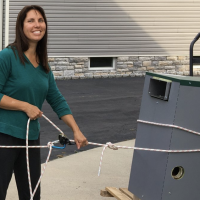Venting before dropping into a water seal
One of Dan's steam trap rules (venting after a trap before dropping into a water seal) seams to apply to an issue I have. I've got a return that drops into a slab to avoid a garage door. The...
.…
...
....
My question is, should I install vents after each radiator trap and the crossover trap or put a larger vent on the return before it drops into the floor?
Like so....
As it stands neither rad heats at all. The crossover is at the end of a ~50' x 1 1/4" main.
Comments
-
You certainly need a vent somewhere before that pipe drops under the garage door…
BUT
what is the water level in the boiler on the far side? If the water level in the boiler on the far side is above that pipe more or less at floor level, no amounting of venting will do any good at all, since the pipe will be full of water at all times. Nor is the trap you label as a crossover doing anything if that is the case…
Br. Jamie, osb
Building superintendent/caretaker, 7200 sq. ft. historic house museum with dependencies in New England1 -
Sorry Jaime, I forgot to say that all returns are pumped. That one continues on to pickup three other radiators on the same level before dropping into a return tank below the floor. The rads beyond the door heat properly.
0 -
No vent needed if the returns go to a condensate pump or boiler feed pump
0 -
Um… yeah, but in this case there is nice water trap before they get there — so a vent somewhere upstream of where that pipe ducks under the door is needed. Gorton #1 would probably do…
Br. Jamie, osb
Building superintendent/caretaker, 7200 sq. ft. historic house museum with dependencies in New England3 -
-
Right. I knew that I needed to have an atmospheric vent before the water seal for air to escape and allow the steam to force the condensate under the door. Someone put a Hoffman no.4 on the return immediately after it comes back up out of the slab, after the door. A nice thought, but accomplishing nothing. Mainly I was wondering if a master vent placed just before the pipe drops into the floor would be as effective as individual vents placed immediately after each trap since this would be much easier and cheaper to accomplish.
Water finds its own level so there should be no condensate in the return except what's in the water seal below the floor. To me this would make the point where the pipe drops into the floor the best place for a vent as it would allow any air between the closest trap and the beginning of the water seal to escape. I can't see any reason to have vents right after each trap but I defer to those with experience.
0 -
-
Final thought. Since the vent would be after the traps and a fair distance from them, what is the purpose of using an actual stream air vent? If the traps work (they're all getting new tunstall capsules) there shouldn't ever be any steam in the return that would cause the vent to close. Why not bring a few feet of pipe up from where it drops into the slab, turn the top down with a couple of elbows to keep debris from falling in and leave it open to the air? Even the tiny bit of steam that sneaks by before the trap closes its going to condense in 8 - 10 feet of cool/cold 3/4" pipe right?
0 -
-
-
What we normally do that a lot of our old timers did with the steam buildings we have is we would get rid of both 90's on both sides of the door that go into the floor with tee's. Then you would pipe in up over the door from one tee and reconnect to the other tee. That acts as a cross over vent and as long as the condensate is not trapped again then the boiler feed tank vent does the venting.
3 -
I think ideally that's just what I'd do but there are obstacles above the door that would make it pretty tangly. Thanks for the suggestion.
0 -
What @pedmec said is the right answer. The pipe over the door only needs to be 3/4" but I doubt you need that.
If the return goes to the condensate tank any water in the return will push any air bubble back to the tank. The tank is the vent
0
Categories
- All Categories
- 87.4K THE MAIN WALL
- 3.2K A-C, Heat Pumps & Refrigeration
- 61 Biomass
- 429 Carbon Monoxide Awareness
- 120 Chimneys & Flues
- 2.1K Domestic Hot Water
- 5.8K Gas Heating
- 115 Geothermal
- 167 Indoor-Air Quality
- 3.7K Oil Heating
- 77 Pipe Deterioration
- 1K Plumbing
- 6.5K Radiant Heating
- 395 Solar
- 15.7K Strictly Steam
- 3.4K Thermostats and Controls
- 56 Water Quality
- 51 Industry Classes
- 50 Job Opportunities
- 18 Recall Announcements






